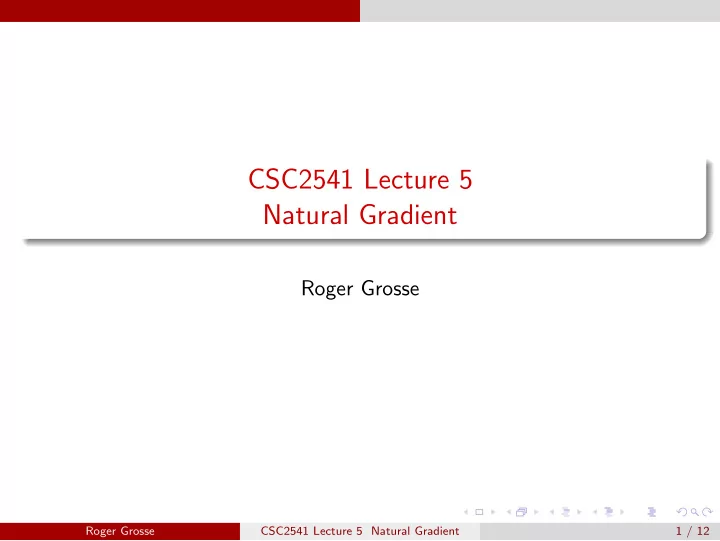

CSC2541 Lecture 5 Natural Gradient Roger Grosse Roger Grosse CSC2541 Lecture 5 Natural Gradient 1 / 12
Motivation Two classes of optimization procedures used throughout ML (stochastic) gradient descent, with momentum, and maybe coordinate-wise rescaling (e.g. Adam) Can take many iterations to converge, especially if the problem is ill-conditioned coordinate descent (e.g. EM) Requires full-batch updates, which are expensive for large datasets Natural gradient is an elegant solution to both problems. How it fits in with this course: This lecture: it’s an elegant and efficient way of doing variational inference Later: using probabilistic modeling to make natural gradient practical for neural nets Bonus groundbreaking result: natural gradient can be interpreted as variational inference! Roger Grosse CSC2541 Lecture 5 Natural Gradient 2 / 12
Motivation SGD bounces around in high curvature directions and makes slow progress in low curvature directions. (Note: this cartoon understates the problem by orders of magnitude!) This happens because when we train a neural net (or some other ML model), we are optimizing over a complicated manifold of functions. Mapping a manifold to a flat coordinate system distorts distances. Natural gradient: compute the gradient on the globe, not on the map. Roger Grosse CSC2541 Lecture 5 Natural Gradient 3 / 12
Motivation: Invariances Suppose we have the following dataset for linear regression. x 1 x 2 t 114.8 0.00323 5.1 338.1 0.00183 3.2 98.8 0.00279 4.1 . . . . . . . . . This can happen since the inputs have arbitrary units. Which weight, w 1 or w 2 , will receive a larger gradient descent update? Which one do you want to receive a larger update? Note: the figure vastly understates the narrowness of the ravine! Roger Grosse CSC2541 Lecture 5 Natural Gradient 4 / 12
Motivation: Invariances Or maybe x 1 and x 2 correspond to years: x 1 x 2 t 2003 2005 3.3 2001 2008 4.8 1998 2003 2.9 . . . . . . . . . Roger Grosse CSC2541 Lecture 5 Natural Gradient 5 / 12
Motivation: Invariances Consider minimizing a function h ( x ), where x is measured in feet. Gradient descent update: x ← x − α d h d x But d h / d x has units 1/feet. So we’re adding feet and 1/feet, which is nonsense. This is why gradient descent has problems with badly scaled data. Natural gradient is a dimensionally correct optimization algorithm. In fact, the updates are equivalent (to first order) in any coordinate system! Roger Grosse CSC2541 Lecture 5 Natural Gradient 6 / 12
Steepest Descent (Rosenbrock example) Gradient defines a linear approximation to a function: h ( x + ∆ x ) ≈ h ( x ) + ∇ h ( x ) ⊤ ∆ x We don’t trust this approximation globally. Steepest descent tries to prevent the update from moving too far, in terms of some dissimilarity measure D : x k +1 ← arg min � ∇ h ( x k ) ⊤ ( x − x k ) + λ D ( x , x k ) � x Gradient descent can be seen as steepest descent with D ( x , x ′ ) = 1 2 � x − x ′ � 2 . Not a very interesting D , since it depends on the coordinate system. Roger Grosse CSC2541 Lecture 5 Natural Gradient 7 / 12
Steepest Descent A more interesting class of dissimilarity measures is Mahalanobis metrics: D ( x , x ′ ) = ( x − x ′ ) ⊤ A ( x − x ′ ) Steepest descent update: x ← x − λ − 1 A − 1 ∇ h ( x ) Roger Grosse CSC2541 Lecture 5 Natural Gradient 8 / 12
Steepest Descent It’s hard to compute the steepest descent update for an arbitrary D . But we can approximate it with a Mahalanobis metric by taking the second-order Taylor approximation. 2( x − x ′ ) ∂ 2 D D ( x , x ′ ) ≈ 1 ∂ x 2 ( x − x ′ ) One interesting example: simulating gradient descent on a different space. (Rosenbrock example) Later in this course, we’ll use this insight to train neural nets much faster. Roger Grosse CSC2541 Lecture 5 Natural Gradient 9 / 12
Fisher Metric If we’re fitting a probabilistic model, the optimization variables parameterize a probability distribution. The obvious dissimilarity measure is KL divergence: D ( θ , θ ′ ) = D KL ( p θ � p θ ′ ) The second-order Taylor approximation to KL divergence is the Fisher information matrix: ∂ 2 D KL = F = Cov x ∼ p θ ( ∇ θ log p θ ( x )) ∂ θ 2 Roger Grosse CSC2541 Lecture 5 Natural Gradient 10 / 12
Fisher Metric Fisher metric for two different parameterizations of a Gaussian: Roger Grosse CSC2541 Lecture 5 Natural Gradient 11 / 12
Fisher Metric KL divergence is an intrinsic dissimilarity measure on distributions: it doesn’t care how the distributions are parameterized. Therefore, steepest descent in the Fisher metric (which approximates KL divergence) is invariant to parameterization, to the first order. This is why it’s called natural gradient. Update rule: θ ← θ − α F − 1 ∇ θ h This can converge much faster than ordinary gradient descent. (example) Hoffman et al. found that if you’re doing variational inference on conjugate exponential families, the variational inference updates are surprisingly elegant — even nicer than ordinary gradient descent! Roger Grosse CSC2541 Lecture 5 Natural Gradient 12 / 12
Recommend
More recommend